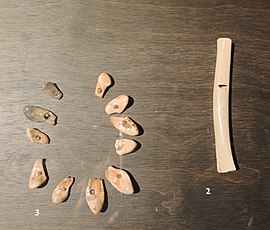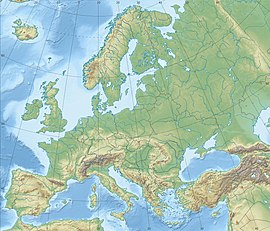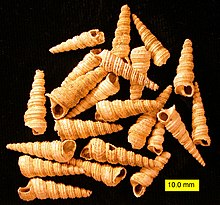| Grottes de Goyet | |
 Finds from Goyet and Trou Magrite in the Museum for Natural Sciences of Belgium Finds from Goyet and Trou Magrite in the Museum for Natural Sciences of Belgium | |
  | |
| Alternative name | Caves of Goyet |
|---|---|
| Location | near Mozet village |
| Region | Samson river valley, Gesves municipality Namur province, Belgium |
| Coordinates | 50°26′48″N 5°00′32″E / 50.44667°N 5.00889°E / 50.44667; 5.00889 |
| Type | carboniferous limestone |
| Length | 250 m (820.21 ft) |
| History | |
| Material | limestone Karst |
| Periods | Middle Palaeolithic to Iron Age |
| Cultures | Aurignacian, Gravettian, Magdalenian |
| Associated with | Neanderthals, Homo sapiens |
| Site notes | |
| Excavation dates | 1867, |
| Archaeologists | Edouard Dupont |
The Goyet Caves (French: Grottes de Goyet) are a series of connected caves located in Belgium in a limestone cliff about 15 m (50 ft) above the river Samson near the village of Mozet in the Gesves municipality of the Namur province. The site is a significant locality of regional Neanderthal and European early modern human occupation, as thousands of fossils and artifacts were discovered that are all attributed to a long and contiguous stratigraphic sequence from 120,000 years ago, the Middle Paleolithic to less than 5,000 years ago, the late Neolithic. A robust sequence of sediments was identified during extensive excavations by geologist Edouard Dupont, who undertook the first probings as early as 1867. The site was added to the Belgian National Heritage register in 1976.
Site
Located just south of the Goyet Castle the caves are essentially 250 m (820.21 ft) long underground galleries, rich in speleothems and carved out of the limestone during millions of years by the waters of the Samson river inside the 90 ha (222.39 acres) limestone massif.
The massif is divided into zones:
- Terrasse classique
- Troisième Caverne
- Abri supérieur
- Trou du Moulin
In 1999, an extensive network of galleries was discovered, consisting of a central and peripheral networks, named after particular areas: Régal des Fees, Atlantide, Salle de Cristal etc.
Excavations


Stratigraphy
Edouard Dupont identified five sediment horizons or site concentrations in the cave, three near the cave entrance and two in deeper chambers. Marcel Otte resumed excavations during the 1970s. Further excavations took place from 1998 to 2004. Contemporary researchers assert that Dupont's 19th century excavation methods "did not meet today’s standards". His sediment sequences are considered to be of little reliability and his discoveries in the archives of the Royal Belgielsan Institute of Natural Sciences have been reviewed and re-classified in recent years.
- Horizon 1: Magdalenian (radiocarbon AMS dating on animal bone, ranging between 14,300 and 31,750 years ago)
- Horizon 2: Magdalenian (two dates, 14,100 to 14,760 years ago, one 29,420 uncalibrated)
- Horizon 3: Multiple mixed occupations including Aurignacian (three dates, 23,400 to 27,600 years ago)
- Horizon 4: Gravettian
- Horizon 5: primarily cave bear and cave lion bones
Objects
The site accounts for a remarkable variety of prehistoric objects: thousands of bones of prehistoric humans and large mammals, a whistle, stone artifacts with stylized engravings, an approximately 5,000-year-old child's grave, the fossilized cranium of a Paleolithic dog, a knife made from a human rib, the largest collection of Neanderthal fossils of Northern Europe, hand axes, harpoons, necklaces, ivory chopsticks, engraved ivory platelets, carved reindeer horn and skinned and filleted human remains, that suggest cannibalism among Neanderthals.
Horizons 1 and 2 (artifacts of the Magdalenian levels) include hand axes and a harpoon, a necklace of 26 wolves perforated teeth, bone fragments and needles, a biserial (multiple barbs on both edges) bone harpoon, a necklace, and a Turritella sea snail shell necklace.
Horizon 4 included a fossilized canid skull, which has been direct AMS dated to be 31,000 years old.
Additional artifacts can be found in numerous private collections, as during the 1950s several amateur archaeologists were permitted access to the caves.
Dog skull
Discovered during the 1860s, a dog-like cranium identified as being that of a Paleolithic dog was AMS dated to 31,680 years old. Mitochondrial DNA indicates that the canid was not a direct ancestor of modern dogs, but rather of an extinct side branch or an aborted domestication attempt.
Carbon Dated fossils:
| Lab number | Material | Normalized Age | Locality |
|---|---|---|---|
| Beta-239920 | bone (skull) domesticated dog | 31680 ± 750 | local |
| OxA-V-2223-49 | Single bone arcelini Equus caballus (Horse) | 29420 ± 170 | local |
| KIA-18986 | Single bone from rear of Chamber A Ursus spelaeus | 27440 ± 170 | local |
| KIA-22275 | Single bone Alopex lagopus (Arctic fox) | 12380 ± 60 | local |
| Lv-2135 | bone | 11630 ± 150 | local |
Source:
Human habitation
Neanderthal habitation

Neanderthal habitation of the caves dates back to the Middle Paleolithic. Occasional Neanderthal occupation begins 120,000 years ago and ends after 40,000 years ago.
Between 45,500 and 40,500 years ago Neanderthals lived in the Troisième Caverne, where 99 bones were discovered, that belong to at least five individuals. This represents the largest collection of Neanderthal fossils in Northern Europe. The condition of the fossils strongly suggests cannibalism. The bodies are skinned and filleted, the bones show cut marks and were cracked to extract the marrow. Reindeer remains from the site have the same types of butcher marks.
In 2018, researchers succeeded in extracting nuclear DNA from Goyet Q56-1, a right femur from a Neanderthal directly dated to around 43,000-42,080 BP. DNA analysis reveals that Goyet Q56-1 was female. Compared to other Neanderthals for which nuclear DNA has been extracted, Goyet Q56-1 is genetically closest to Spy94a from Spy Cave and groups closest with other Late European Neanderthals.
Homo sapiens occupation

 Goyet
Kostenki
Sungir
Zlatý kůň
Ust'-Ishim
Oase
Bacho Kiro
Tianyuan
Initial Upper Paleolithic wave
Goyet
Kostenki
Sungir
Zlatý kůň
Ust'-Ishim
Oase
Bacho Kiro
Tianyuan
Initial Upper Paleolithic wave"East-Eurasian" |
Homo sapiens occupation began around 35,000 years ago. Goyet accounts for fossils of European populations from different junctures, including fossils that are among the earliest branch of modern Europeans (ca. 35,000 BP). Their damaged but readable DNA has been used in studies of the origin and migration of European ice age populations. Based on mitochondrial DNA of five local fossils it was concluded that the first modern Europeans arrived directly from Africa without a detour via Asia. The 35,000 year old humerus of a man from Goyet has been associated with the Aurignacian culture. Shortly thereafter, the population associated with this culture was ousted by a genetically distinct Gravettian rural population (from 34,000 BP), but around 25,000 BP descendants reappear in Spain in the context of Magdalenian culture. After 19,000 years ago the population begins to spread all over Europe. The extent to which Neanderthals and Homo sapiens have lived together at Goyet is still under investigation.
In 1998, the bones of a twelve-year-old child was found in a crevice. The cavern was subsequently named the Salle de l'Enfant. The remains are 5,000 years old and are interpreted as representing a grave. Other cultural type elements such as perforated tubes that were perhaps used as flutes, indicate that the caves continued to be inhabited during the late Neolithic. An even younger object discovered in Goyet, attributed to the Iron Age (around 500 BCE), is a knife made from a human rib.
In 2016, researchers successfully extracted DNA from several ancient human fossils at Goyet (with direct dates): GoyetQ116-1 (35,160-34,430 BP) and GoyetQ376-3 (33,940-33,140 BP) from the Aurignacian; GoyetQ376-19 (27,720-27,310 BP), GoyetQ53-1 (28,230-27,720 BP), GoyetQ55-2 (27,730-27,310 BP), GoyetQ56-16 (26,600-26,040 BP) and Goyet2878-21 (27,060-26,270 BP) from the Gravettian; and GoyetQ-2 (15,230-14,780 BP) from the Magdalenian. GoyetQ376-19, Goyet53-1 and Goyet56-16 were found to cluster genetically with several other Gravettian individuals from Europe in the Věstonice Cluster, while GoyetQ-2 was found to cluster genetically with several other Magdalenian individuals from Europe in the El Mirón Cluster.
All later Europeans after GoyetQ116-1 show some genetic affinity for this individual. GoyetQ116-1 also exhibits more genetic affinity for the Tianyuan man than any other ancient individual from West Eurasia. GoyetQ116-1 may have received geneflow from an Ancient East Eurasian population (c. 14–23%). Culturally, the Aurignacian cultural complex is chronologically associated with the human remains of Goyet Q116-1, while the subsequent Gravettian is associated with the Vestonice cluster.
See also
References
- ^ "The caves that prove Neanderthals were cannibals". Phys.org. Retrieved January 9, 2017.
- "Goyet Cave (Belgium) - Evidence for Early Dog Domestication". Archaeology about com. Archived from the original on November 8, 2016. Retrieved January 9, 2017.
- "The Caves of Goyet - Landscape & Nature - Discover -". Beauxvillages.be. Archived from the original on July 20, 2021. Retrieved January 9, 2017.
- "365 Discovery days - Tourist Attractions and Museums in Belgium - Goyet Caves". 365.be. Retrieved January 9, 2017.
- "Amazing Belgium: Caves of Goyet". Amazingbelgium.be. Retrieved January 9, 2017.
- Rougier, Hélène; Crevecoeur, Isabelle; Beauval, Cédric; Posth, Cosimo; Flas, Damien; Wißing, Christoph; Furtwängler, Anja; Germonpré, Mietje; Gómez-Olivencia, Asier; Semal, Patrick; Van Der Plicht, Johannes; Bocherens, Hervé; Krause, Johannes (2016). "Neandertal cannibalism and Neandertal bones used as tools in Northern Europe : Scientific Reports - it appears that the levels described by Dupont actually represent a mix of material from different periods". Scientific Reports. 6: 29005. Bibcode:2016NatSR...629005R. doi:10.1038/srep29005. PMC 4933918. PMID 27381450.
- Peigne, S.; Goillot, C.; Germonpre, M.; Blondel, C.; Bignon, O.; Merceron, G. (2009). "Predormancy omnivory in European cave bears evidenced by a dental microwear analysis of Ursus spelaeus from Goyet, Belgium". Proceedings of the National Academy of Sciences. 106 (36): 15390–15393. Bibcode:2009PNAS..10615390P. doi:10.1073/pnas.0907373106. PMC 2741261. PMID 19706401.
- Gould, Charles (December 10, 2013). Mythical Monsters (Illustrated Edition) - Charles Gould -. Jazzybee Verlag. ISBN 9783849641825. Retrieved January 9, 2017.
- Stevens, Rhiannon E.; Germonpré, Mietje; Petrie, Cameron A.; O'Connell, Tamsin C. (2009). "Palaeoenvironmental and chronological investigations of the Magdalenian sites of Goyet Cave and Trou de Chaleux (Belgium), via stable isotope and radiocarbon analyses of horse skeletal remains". Journal of Archaeological Science. 36 (3): 653–662. Bibcode:2009JArSc..36..653S. doi:10.1016/j.jas.2008.10.008.
- "Grottes de Goyet (Grotten van Goyet (NL) / Caves of Goyet (EN)) Cave or Rock Shelter : The Megalithic Portal and Megalith Map". Megalithic.co.uk. Retrieved January 9, 2017.
- "The fossil cave hyena of Goyet" (PDF). Lib ugent be. Retrieved January 9, 2017.
- Germonpré, Mietje; Sablin, Mikhail V.; Stevens, Rhiannon E.; Hedges, Robert E.M.; Hofreiter, Michael; Stiller, Mathias; Després, Viviane R. (2009). "Fossil dogs and wolves from Palaeolithic sites in Belgium, the Ukraine and Russia: osteometry, ancient DNA and stable isotopes". Journal of Archaeological Science. 36 (2): 473–490. Bibcode:2009JArSc..36..473G. doi:10.1016/j.jas.2008.09.033.
- ^ Thalmann, O.; Shapiro, B.; Cui, P.; Schuenemann, V. J.; Sawyer, S. K.; Greenfield, D. L.; Germonpre, M. B.; Sablin, M. V.; Lopez-Giraldez, F.; Domingo-Roura, X.; Napierala, H.; Uerpmann, H.-P.; Loponte, D. M.; Acosta, A. A.; Giemsch, L.; Schmitz, R. W.; Worthington, B.; Buikstra, J. E.; Druzhkova, A.; Graphodatsky, A. S.; Ovodov, N. D.; Wahlberg, N.; Freedman, A. H.; Schweizer, R. M.; Koepfli, K.- P.; Leonard, J. A.; Meyer, M.; Krause, J.; Paabo, S.; et al. (2013). "Complete Mitochondrial Genomes of Ancient Canids Suggest a European Origin of Domestic Dogs". Science. 342 (6160): 871–874. Bibcode:2013Sci...342..871T. doi:10.1126/science.1243650. hdl:10261/88173. PMID 24233726. S2CID 1526260.
- "CARD Belgium / SUNK-2335 (Goyet)". Canadianarchaeology.ca. Retrieved January 9, 2017.
- ^ Rougier, Hélène; Crevecoeur, Isabelle (July 6, 2016). "Neandertal cannibalism and Neandertal bones used as tools in Northern Europe". Scientific Reports. 6 (1): 29005. Bibcode:2016NatSR...629005R. doi:10.1038/srep29005. ISSN 2045-2322. PMC 4933918. PMID 27381450.
Our results show that the Neandertals from the Troisième caverne of Goyet were butchered, with the hypothesis of their exploitation as food sources the most parsimonious explanation for the observed bone surface modifications. Goyet provides the first unambiguous evidence of Neandertal cannibalism in Northern Europe and given the dates obtained on the Neandertal remains, it is most likely that they were processed by their fellow Neandertals as no modern humans are known to have been in the region at the time17,23. However, the available data make it impossible to determine whether the modifications observed on the Neandertal skeletal material represent symbolic practices or simply result from the processing of immediately available sources of food.
- "Researchers discover the first evidence of Neanderthal cannibalism in northern Europe". Https. Retrieved January 9, 2017.
- Hajdinjak, Mateja; Fu, Qiaomei; Hübner, Alexander; Petr, Martin; Mafessoni, Fabrizio; Grote, Steffi; Skoglund, Pontus; Narasimham, Vagheesh; Rougier, Hélène; Crevecoeur, Isabelle; Semal, Patrick; Soressi, Marie; Talamo, Sahra; Hublin, Jean-Jacques; Gušić, Ivan; Kućan, Željko; Rudan, Pavao; Golovanova, Liubov V.; Doronichev, Vladimir B.; Posth, Cosimo; Krause, Johannes; Korlević, Petra; Nagel, Sarah; Nickel, Birgit; Slatkin, Montgomery; Patterson, Nick; Reich, David; Prüfer, Kay; Meyer, Matthias; Pääbo, Svante; Kelso, Janet (2018). "Reconstructing the genetic history of late Neanderthals" (PDF). Nature. 555 (7698): 652–656. Bibcode:2018Natur.555..652H. doi:10.1038/nature26151. hdl:1887/70268. ISSN 0028-0836. PMC 6485383. PMID 29562232.
- Keane, A. H. (June 9, 2011). Ethnology: Fundamental Ethnical Problems; The Primary Ethnical Groups - A. H. Keane -. Cambridge University Press. ISBN 9781107648135. Retrieved January 9, 2017.
- ^ Fu, Qiaomei; Posth, Cosimo; Hajdinjak, Mateja; Petr, Martin; Mallick, Swapan; Fernandes, Daniel; Furtwängler, Anja; Haak, Wolfgang; Meyer, Matthias; Mittnik, Alissa; Nickel, Birgit; Peltzer, Alexander; Rohland, Nadin; Slon, Viviane; Talamo, Sahra; Lazaridis, Iosif; Lipson, Mark; Mathieson, Iain; Schiffels, Stephan; Skoglund, Pontus; Derevianko, Anatoly P.; Drozdov, Nikolai; Slavinsky, Vyacheslav; Tsybankov, Alexander; Cremonesi, Renata Grifoni; Mallegni, Francesco; Gély, Bernard; Vacca, Eligio; Morales, Manuel R. González; Straus, Lawrence G.; Neugebauer-Maresch, Christine; Teschler-Nicola, Maria; Constantin, Silviu; Moldovan, Oana Teodora; Benazzi, Stefano; Peresani, Marco; Coppola, Donato; Lari, Martina; Ricci, Stefano; Ronchitelli, Annamaria; Valentin, Frédérique; Thevenet, Corinne; Wehrberger, Kurt; Grigorescu, Dan; Rougier, Hélène; Crevecoeur, Isabelle; Flas, Damien; Semal, Patrick; Mannino, Marcello A.; Cupillard, Christophe; Bocherens, Hervé; Conard, Nicholas J.; Harvati, Katerina; Moiseyev, Vyacheslav; Drucker, Dorothée G.; Svoboda, Jiří; Richards, Michael P.; Caramelli, David; Pinhasi, Ron; Kelso, Janet; Patterson, Nick; Krause, Johannes; Pääbo, Svante; Reich, David (2016). "The genetic history of Ice Age Europe". Nature. 534 (7606): 200–205. Bibcode:2016Natur.534..200F. doi:10.1038/nature17993. hdl:10211.3/198594. ISSN 0028-0836. PMC 4943878. PMID 27135931.
- Yang, Melinda A.; Gao, Xing; Theunert, Christoph; Tong, Haowen; Aximu-Petri, Ayinuer; Nickel, Birgit; Slatkin, Montgomery; Meyer, Matthias; Pääbo, Svante; Kelso, Janet; Fu, Qiaomei (2017). "40,000-Year-Old Individual from Asia Provides Insight into Early Population Structure in Eurasia". Current Biology. 27 (20): 3202–3208.e9. Bibcode:2017CBio...27E3202Y. doi:10.1016/j.cub.2017.09.030. ISSN 0960-9822. PMC 6592271. PMID 29033327.
- Massilani, Diyendo; Skov, Laurits; Hajdinjak, Mateja; Gunchinsuren, Byambaa; Tseveendorj, Damdinsuren; Yi, Seonbok; Lee, Jungeun; Nagel, Sarah; Nickel, Birgit; Devièse, Thibaut; Higham, Tom; Meyer, Matthias; Kelso, Janet; Peter, Benjamin M.; Pääbo, Svante (October 30, 2020). "Denisovan ancestry and population history of early East Asians". Science. 370 (6516): 579–583. doi:10.1126/science.abc1166. ISSN 0036-8075.
- Fu, Qiaomei (2016). "The genetic history of Ice Age Europe". Nature. 534 (7606): 200–205. Bibcode:2016Natur.534..200F. doi:10.1038/nature17993. PMC 4943878. PMID 27135931.
GoyetQ116-1 is chronologically associated with the Aurignacian cultural complex. Thus, the subsequent spread of the Vestonice Cluster, which is associated with the Gravettian cultural complex, shows that the spread of the latter culture was mediated at least in part by population movements.
Bibliography
- Mark Derr (October 27, 2011). How the Dog Became the Dog: From Wolves to Our Best Friends. The Overlook Press. pp. 69–. ISBN 978-1-59020-991-2.
External links
| Prehistoric technology | |||||||||||||||||||||
|---|---|---|---|---|---|---|---|---|---|---|---|---|---|---|---|---|---|---|---|---|---|
| |||||||||||||||||||||
| |||||||||||||||||||||
| |||||||||||||||||||||